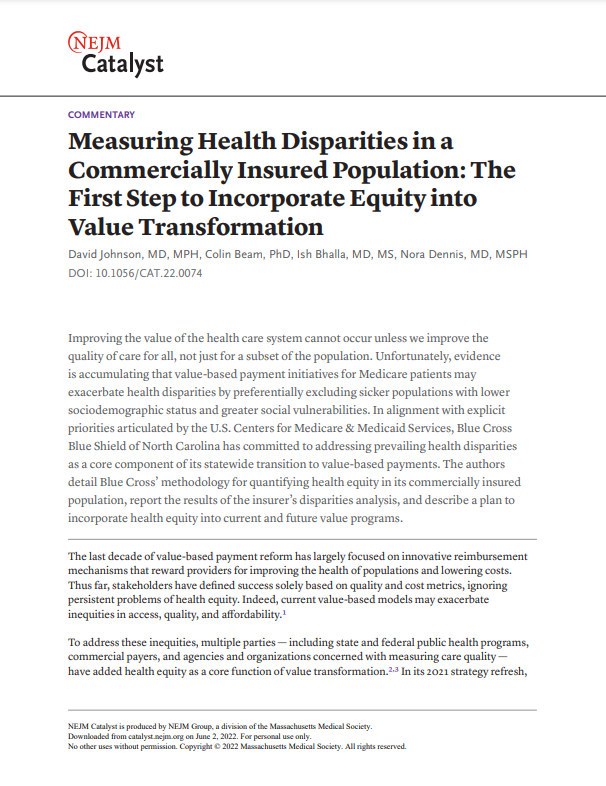June 16, 2022  Colin Beam, PhD
Colin Beam, PhD
NEJM Catalyst: analysis of healthcare disparities for health insurer

Ursa Health Blog
Visit Ursa Health's blog to gain healthcare data analytics insights or to get to know us a little better. Read more ...
NASHVILLE, Tenn., June 16, 2022 — Ursa Health’s analytics development platform, Ursa Studio, enabled an analysis of healthcare inequities in utilization and spending published on June 2 in NEJM Catalyst. The article highlights cost and quality insights into the commercially insured population of Blue Cross and Blue Shield of North Carolina (Blue Cross NC) resulting from Blue Cross NC’s collaboration with Ursa Health.
“Measuring and improving quality is an essential component to transitioning our healthcare system to one that incentives better outcomes rather than more services,” said David Johnson, MD, MPH, principal author of the paper and clinical operating partner at Rubicon Founders, who was medical director for value transformation at Blue Cross NC during the research period that led to the paper. “However, improving quality for only certain groups of people exacerbates existing health disparities and should not be seen as a success. Healthcare stakeholders must get comfortable taking accountability for addressing the systemic and pervasive inequities in our healthcare system. Identifying these disparities is a formidable analytical challenge, and Ursa Health enabled us to develop the information and insights we needed.”
“Using Ursa Studio, we were able to apply a validated measure of socioeconomic disadvantage to quality, utilization, and cost metrics to understand where and why disparities occur, as well as quantify their magnitude. This is where the hard work of value-based transformation starts,” explained Colin Beam, PhD, vice president of Advanced Analytics at Ursa Health and one of the paper’s co-authors. “Blue Cross NC is at the forefront of efforts to eliminate unfair disparities in health and health care between various groups to achieve the highest level of health for all people, and we are proud to support them in this important work.”
Ursa Studio helped Blue Cross NC analyze 2.5 years of claims data for its membership, 98.4% of which were in its commercial line of business and 1.6% in its Medicare Advantage offering. Member-level socioeconomic disadvantage was imputed using the University of Wisconsin’s Area Deprivation Index (ADI). Members were stratified into five groups, with a focus on comparing the most socioeconomically disadvantaged (group 5) with the least (group 1). Of the overall population, 13% fell into the highest deprivation quintile, while 9.4% fell into the lowest deprivation quintile.
The research examined (by quintile):
- Utilization and cost outcomes across the membership
- Membership in the health plan’s flagship accountable care organization (ACO) network
- Chronic kidney disease (CKD) and end-stage renal disease (ESRD)
- Maternal and perinatal health
Key findings included the following:
- Those in the highest deprivation quintile were higher users of the emergency department (ED) and less frequent users of upstream disease prevention and health optimization services, despite having commercial insurance coverage for these services. In addition, they were more frequently hospitalized and readmitted to the hospital.
- In addition, this group was disproportionately underrepresented in the ACO program.
- Although advanced kidney disease disproportionately affects the more vulnerable, cost, quality, and utilization are relatively consistent across socioeconomic status.
- Although not statistically significant, births in the highest deprivation quintile resulted in higher costs, driven by higher rates of preterm birth, cesarean delivery, postpartum admission or ED visit, and severe maternal morbidity.
From this foundation, Blue Cross NC has been able to both confirm the presence of disparities and formulate a plan of action for achieving health equity. Read the paper, “Measuring Health Disparities in a Commercially Insured Population: The First Step to Incorporate Equity into Value Transformation,” in the New England Journal of Medicine (NEJM) Catalyst Innovations in Care Delivery.
Ursa Health works with organizations that depend on healthcare data to guide clinical, financial, and operational decisions, uniting the producers and the users of analytics in the pursuit of innovation. Ursa Studio, the company’s no-code analytics development platform, combines pre-built content with no-code technology to facilitate customization and maintenance, helping to accelerate the construction of a strong yet adaptable structure for analytics-guided innovation and growth. Using this structure, organizations can take advantage of their rich data resources to generate relevant, accurate, and timely answers to questions in any area of their business.